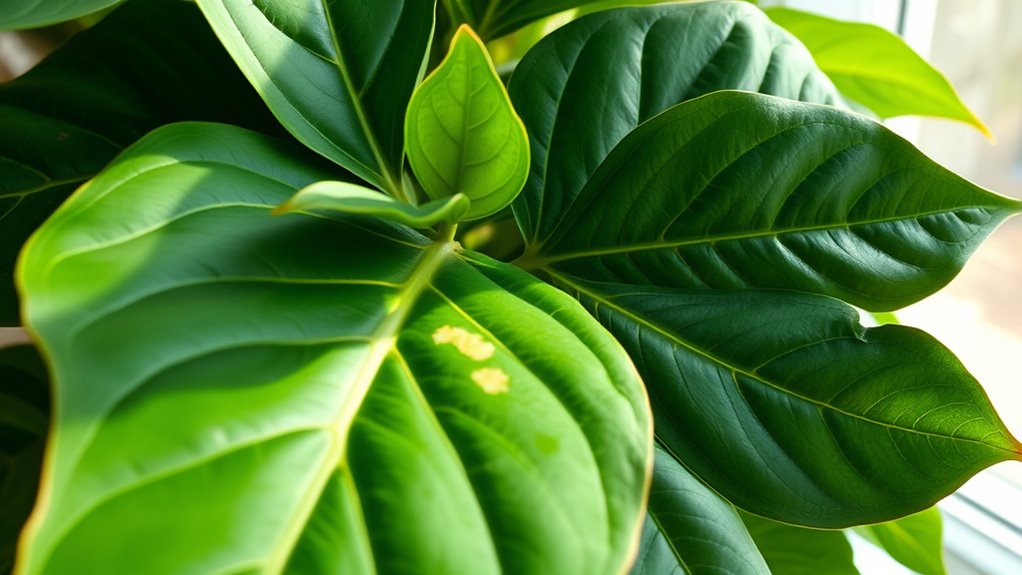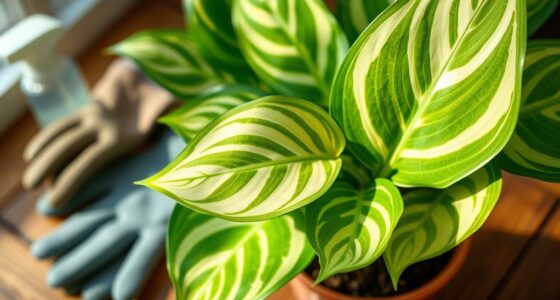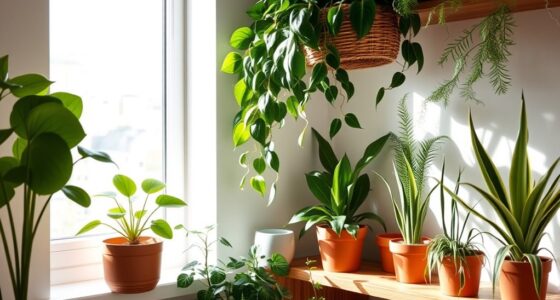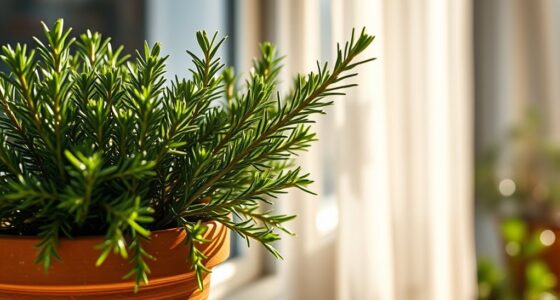To keep your fiddle leaf fig healthy, guarantee it gets bright, indirect light and uses pots with drainage holes. Water only when the top 2 inches of soil are dry, and avoid overwatering to prevent root rot. Address yellowing or leaf drop by adjusting light and humidity, and treat pests promptly. Fix brown tips with proper watering and humidity, and prune damaged leaves. Continuing with these guidelines will help you identify and solve common problems effectively.
Key Takeaways
- Ensure bright, indirect light and proper drainage to prevent root rot and leaf issues.
- Water only when top 2 inches of soil are dry, adjusting seasonally to avoid overwatering.
- Address yellowing or brown tips by adjusting humidity, watering, and inspecting for pests or diseases.
- Rotate the plant regularly and maintain consistent environmental conditions to prevent growth abnormalities.
- Regularly check for pests, clean affected leaves, and improve airflow to control infestations and leaf damage.
Recognizing and Addressing Leaf Drop and Yellowing
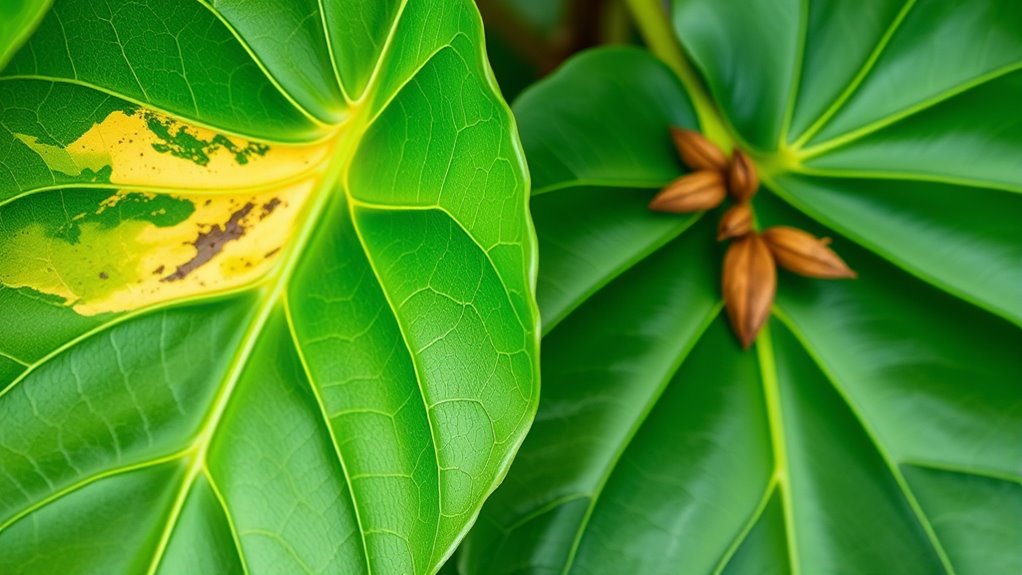
Recognizing and addressing leaf drop and yellowing in your fiddle leaf fig begins with understanding the underlying causes. Leaf drop often results from sudden environmental changes, like moving the plant or seasonal shifts, which stress the plant and trigger leaf loss. Incorporating consistent watering routines can help your plant adapt more smoothly and reduce stress-related leaf drop. Yellowing leaves typically signal overwatering, as excess moisture promotes root rot and hampers nutrient uptake. Underwatering and low humidity can cause leaves to yellow at the edges and droop, showing your plant needs more consistent watering and humidity. Both issues can be managed by maintaining stable conditions—steady temperature, light, and watering routines—to reduce plant stress. Monitoring soil moisture regularly and watering only when the top 2 inches are dry helps prevent overwatering-related problems, encouraging healthier, more resilient foliage. Additionally, understanding plant stress signals enables you to respond promptly and effectively to changes in your plant’s health. Creating a stable environment and practicing consistent care minimizes fluctuations that can negatively impact your fiddle leaf fig’s overall well-being. Paying attention to environmental stability can further promote your fiddle leaf fig’s overall well-being.
Managing Brown Tips, Spots, and Patchy Discoloration
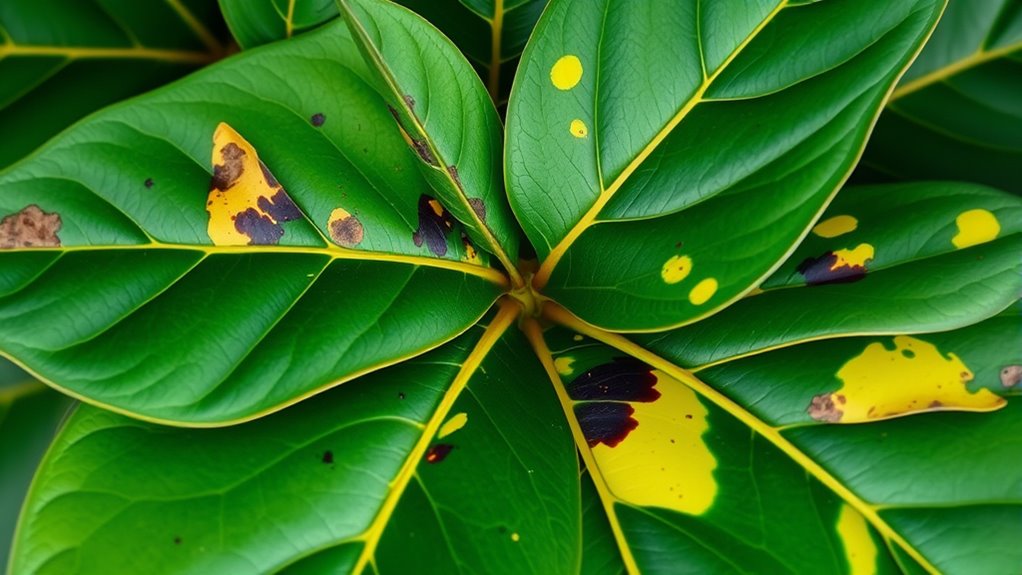
Brown tips, spots, and patchy discoloration on your fiddle leaf fig often indicate environmental stress or health issues that need prompt attention. Brown tips may result from underwatering, low humidity below 60%, or physical plant damage, causing crispy edges. Support hours for plant care advice can help determine the best treatment strategies. Leaf spots and patches can signal bacterial infections, fungal issues, or pest infestations like scale or mealybugs. Overwatering can lead to root rot, contributing to discoloration, while sunburn from sudden direct sunlight causes white or tan patches. Nutrient deficiencies may also produce patchy yellowing and brown edges. Maintaining proper plant health through regular inspection and care is essential for preventing these problems. To manage these issues, adjust your watering schedule, increase humidity, and gradually acclimate your plant to brighter light. Proper stove safety and environment management are crucial to prevent additional stressors that could harm your plant. Regularly remove damaged or discolored leaves to promote healthy growth and prevent further issues.
Correcting Growth Abnormalities and Physical Damage
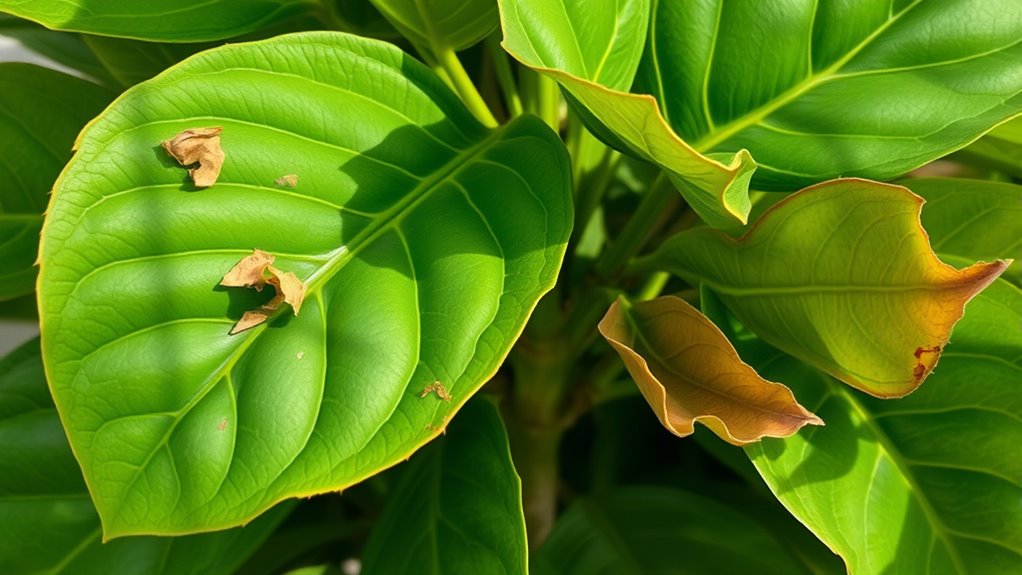
To correct growth abnormalities and physical damage on your fiddle leaf fig, start by identifying the cause, such as uneven sunlight, underwatering, or pest infestation. Address uneven sunlight by rotating the plant weekly. For cracking leaves or physical injury, ensure consistent watering and humidity, which strengthen foliage. Pest issues like webbing indicate mites; remove pests and treat with insecticidal soap. Severe growth problems may require pruning and propagation from healthy cuttings to encourage balanced growth. Proper plant care practices are essential for maintaining healthy growth. Using vetted planters designed for optimal moisture control can help prevent some growth issues related to watering problems. Additionally, selecting the right watering techniques can significantly improve overall plant health. Regular monitoring of your plant’s health helps catch problems early and maintain its overall well-being.
Identifying and Treating Pest Infestations
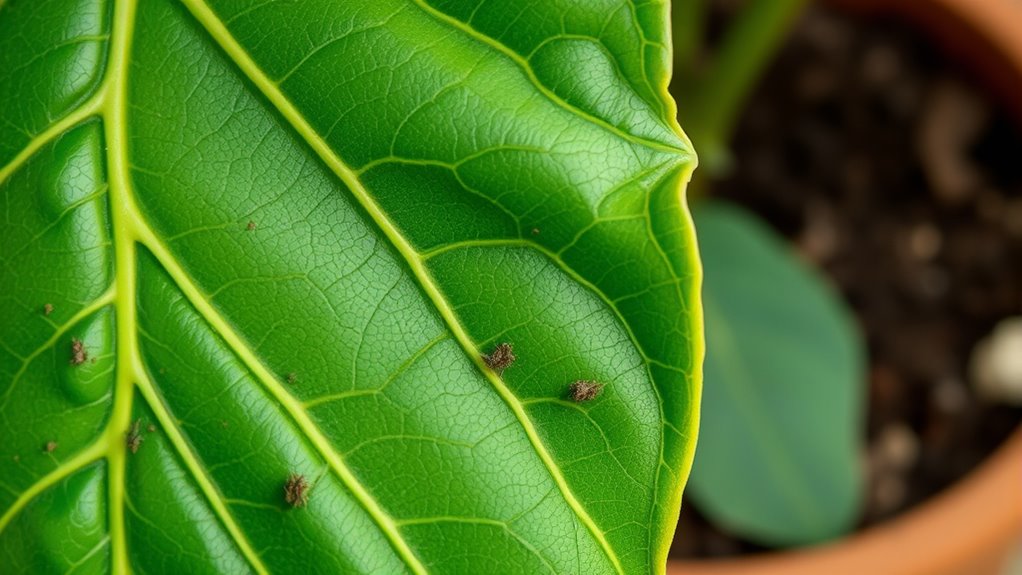
Pest infestations can quickly undermine the health of your fiddle leaf fig if left unchecked. To prevent damage, inspect your plant regularly with a magnifying glass for signs like spider mites, white fluff, or sticky residue. Look closely at the undersides of leaves and stems. Spotting pests early makes treatment easier. Implementing regular maintenance practices can help keep pests at bay and ensure your plant remains healthy. Regular inspections and early detection are essential for controlling outbreaks before they become severe. Common pests include mealybugs, scale insects, and spider mites. To treat, wipe pests off with alcohol-soaked cotton swabs or spray with insecticidal soap or neem oil. It’s also beneficial to understand the life cycle of pests to target them effectively during vulnerable stages. Understanding the environmental conditions that favor pest development can help you create a less hospitable environment for them. Proper plant hygiene and avoiding overwatering can further reduce pest attraction. Isolate infected plants immediately to stop pests from spreading. Consistent monitoring and early detection are key. Keeping a close eye allows you to catch infestations before they cause serious harm, ensuring your fiddle leaf fig stays healthy and vibrant.
Troubleshooting Watering, Humidity, and Environmental Stress

Properly troubleshooting your fiddle leaf fig’s watering, humidity, and environment is vital for its health. Overwatering can cause root rot and yellowing leaves, so ensure the soil dries out 2-3 inches deep before watering again. Using a moisture meter can help accurately assess soil moisture levels and prevent overwatering. Additionally, adjusting watering habits based on seasonal changes can prevent stress caused by inconsistent moisture levels.
Maintaining humidity levels above 60% helps prevent brown leaf tips and leaf cracking caused by low moisture. Using a humidifier or placing a water tray with pebbles can boost ambient humidity around the plant. Consistent humidity is essential, especially during dry winter months when indoor heating reduces moisture in the air. Proper humidity levels are also supported by understanding how climate affects plant health.
Sudden environmental changes, like drafts or moving the plant to a colder or drier spot, can stress it and lead to leaf damage or leaf drop. Ensuring consistent environmental conditions with stable temperature, humidity, and light levels are essential to prevent stress-related issues like leaf curling and drooping, supporting overall plant health. Regularly inspecting your plant for signs of distress and adjusting care routines accordingly can help maintain its vitality and prevent issues such as leaf browning or drooping.
Preventing and Fixing Root Rot and Other Soil-Related Issues
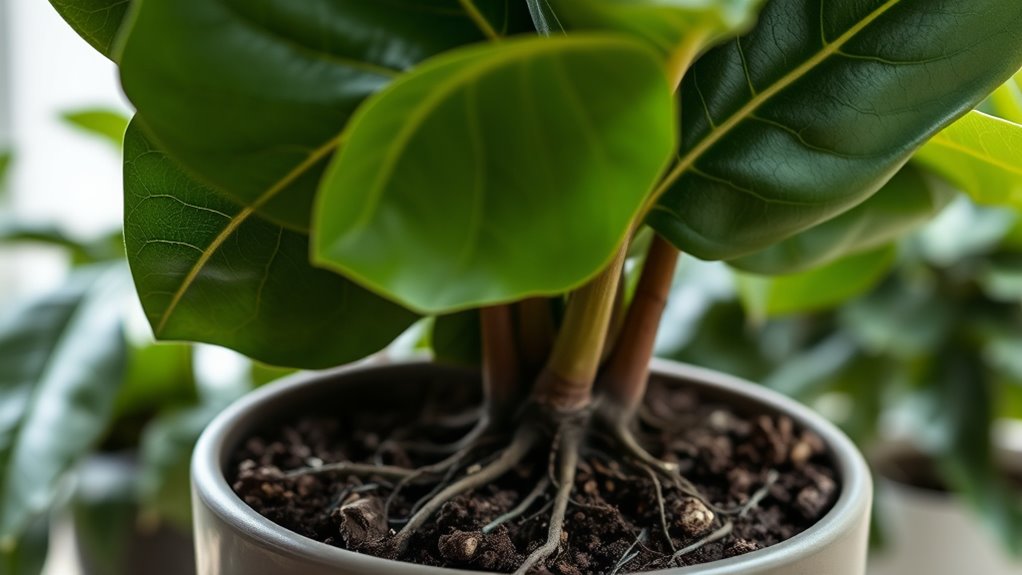
To prevent root rot, you need to guarantee your fiddle leaf fig’s pot has proper drainage with holes and well-draining soil. Water only when the top inch or two of soil is dry, and always remove excess water from saucers promptly. Using these techniques helps keep roots healthy and avoids common soil-related problems. Additionally, ensuring your plant receives adequate light conditions can promote healthy growth and prevent issues related to moisture imbalance.
Proper Drainage Techniques
Making certain your fiddle leaf fig’s pot has at least one drainage hole is essential for preventing water from accumulating at the bottom, which can lead to root rot. Proper soil drainage allows excess water to escape, keeping the soil aerated and healthy. Additionally, using well-draining soil mixes like potting soil combined with perlite and peat helps maintain ideal moisture levels and reduce the risk of waterlogged soil. Elevate the pot slightly off the saucer or tray to prevent standing water from accumulating underneath. Adjust watering frequency based on soil moisture—wait until the top 2 inches are dry before watering again. Regularly check soil moisture with your finger or a moisture meter to avoid excess water that could cause root rot. Patterns of behavior in watering can sometimes contribute to overwatering, so establishing a consistent schedule is beneficial.
- Make certain your pot has drainage holes for proper pot drainage
- Use well-draining soil mixes to prevent waterlogged soil
- Elevate the pot to avoid standing water underneath
- Monitor moisture levels regularly before watering
- Adjust watering frequency based on soil conditions
Optimal Watering Practices
Monitoring your soil moisture carefully helps prevent root rot and other soil-related problems. You should water your fiddle leaf fig only when the top 2 inches of soil are dry, avoiding overwatering and waterlogging. Good drainage is essential—use a pot with drainage holes and remove excess water from saucers within 30 minutes.
Regularly check soil moisture with your finger or a moisture meter to maintain consistent watering habits. Adjust your watering frequency seasonally: water less in winter when growth slows and more during spring and summer.
Proper soil moisture levels prevent drought stress and soil issues. By paying attention to topsoil dryness and ensuring proper drainage, you promote healthy roots and avoid problems caused by improper watering habits.
Frequently Asked Questions
What Are Common Problems With Fiddle Leaf Figs?
You might notice your fiddle leaf fig developing yellowing, browning, or spotting leaves, often due to overwatering, underwatering, or environmental stress.
Pests like spider mites and mealybugs can cause damage, while low humidity or insufficient light lead to curling, drooping, or stunted growth.
Sunburn may create white patches, and poor drainage can result in root rot with mushy roots and dark spots.
Keep an eye out for these issues to keep your plant healthy.
What Does an Overwatered Fiddle Leaf Look Like?
Imagine your fiddle leaf fig as a sponge, soaking up too much water. When overwatered, its leaves turn yellow, limp, and may develop black spots. The soil stays soggy, and roots rot, emitting a foul smell.
You might notice the plant drooping despite watering. Roots become brown, mushy, and decayed. Overwatering suffocates the roots, leading to fungal infections and overall decline of your plant.
What Does a Diseased Fiddle Leaf Fig Look Like?
A diseased fiddle leaf fig shows large, irregular brown patches with yellow rings, or black, dark brown spots that may be mushy and foul-smelling if roots rot.
You might notice yellowing, mottling, or white patches, along with curled, wilting, or crispy edges.
Leaves may drop prematurely, and you could see mold, fungi, or bacterial growth.
These signs indicate your plant is battling infections or diseases needing prompt attention.
Should You Cut the Brown Spots off Fiddle Leaf Fig?
Cutting off brown spots on your fiddle leaf fig can be a game-changer, saving your plant from the brink of disaster. You should only trim localized, dry, or crispy spots, avoiding healthy tissue to prevent stress.
Use sterilized shears for clean cuts, and if the spots are infected, remove entire infected leaves or stems. Regular inspections and pruning promote healthy growth and help stop issues from spreading further.
Conclusion
With these tips, you’re well on your way to a thriving fiddle leaf fig. But beware—some problems might sneak up when you least expect them. Will your plant bounce back from that sudden droop or yellowing? Stay vigilant, keep observing, and act quickly. Your fig’s health depends on your attention. The next challenge could be just around the corner—are you ready to keep your plant happy and beautiful?
